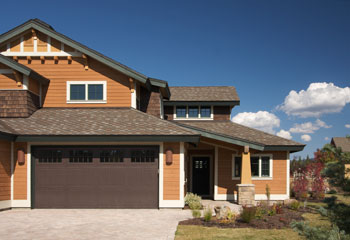Environmentally Safe Roofing Materials
The environmental impact of roofing materials should be one of the main considerations when selecting a new roof for an Idaho home. While all building materials have an environmental impact, some types of roofing materials offer greater sustainability than others. Ultimately, the choice between environmentally friendly and other options will depend on each homeowner’s individual needs and preferences.

Renewable Roofing Materials
Organic and renewable roofing alternatives are emerging as viable options for environmentally-friendly roofing. Substances such as slate, wood, and cedar shakes are harvested from natural sources, so they’re considered renewable. Moreover, organic materials like cork, rubber, and recycled plastic can be recycled and used again for roofing materials. Materials made from organic sources have a longer lifespan than traditional roofing materials, meaning that homeowners usually experience fewer repairs and replacements over the lifetime of their roof.
A lesser-known, yet environmentally-friendly roofing material is the living roof. The living roof is a type of roof that is made of vegetation and soil, which is placed on top of a structure to create a green roof. This type of roof has numerous advantages, including improved insulation, natural stormwater management and even curb appeal.
The Benefits of Recycled Materials
Contents
Using recycled materials for roofing in Idaho can have a handful of advantages. First, it is an environmentally friendly option. Using recycled materials can reduce the need to harvest natural resources, decreasing the cost to construct a roof and avoiding deforestation and other ecological disruptions caused by obtaining resources, many of which come from fragile ecosystems. Reusing materials already harvested from ecosystems is a much more responsible option than taking from them once more. Additionally, recycling material reduces landfill waste, as far more materials are being taken out of the landfill than are put in.
Recycles Roofing Products and Longevity
Second, recycled roofing materials have a longer life span than more traditional materials. Recycled rubber roofing can last for more than 50 years, and the cost of materials tends to be significantly lower than more modern roofing materials, which may have higher initial costs but do not last as long.
On the other hand, recycled roofing materials can present their own challenges. For one, recycled roofing materials may not be as readily available as traditional materials, as they are often sourced from large-scale recycling facilities rather than retail stores. For some, this lack of availability can be a deal-breaker. Additionally, recycled roofing materials may require more maintenance and require a certified technician to install them. This increases the cost of using recycled materials, making them less enticing to some homeowners.
So, while the use of recycled roofing materials can be exciting and rewarding, there are some challenges associated with them. An Idaho roofing company now has options to install a quality roof and take care of the environment. It is important to weigh the pros and cons of using recycled materials before making a decision. With all of this in mind, the next section will explore one of the most important aspects of any roofing decision: insulation.
Attic Insulation and Roofing
Insulation is key for keeping a home comfortable, maintaining energy efficiency, and ensuring a healthy, breathable environment. It is also an important factor in a home’s overall roofing performance, although it often gets less attention than other essential elements such as pitch, material, and coatings.
When it comes to insulating Idaho homes, homeowners have limitless options. Many of which depend on the type of home, the pitch, and the thermal performance needed. Two of the most popular options, however, are spray foam and fiberglass.
Spray Foam Insulation
Spray foam insulation is one of the most expensive and efficient options on the market. It is applied directly onto the roof and over the joists, floor, and walls to form an air-tight, water-resistant envelope and seal. This not only creates a much more efficient and effective seal, but also eliminates thermal bridging, meaning that any cold spots on the roofing material are insulated from the outside air and the warm air from inside the home can remain contained.
Although spray foam is an effective insulator, fiberglass insulation is generally the more cost-effective option for Idaho homes. Fiberglass insulation comes in rolls or batts and is easily installed by cutting-to-fit panels. It also comes in both unfaced and faced varieties and can be mixed and matched for a custom insulation job. It is a good mid-range solution that can provide good but not excessive energy savings for Idaho homes.
Depending on the size and makeup of the home, each of these materials could be a viable solution – though spray foam is often the most effective option when used properly. While fiberglass is bulky and requires more work to install, it’s also much more affordable. Ultimately, both materials offer great options when it comes to insulating Idaho homes.
With so many options out there, it can be daunting to choose the right insulation material. That’s why it’s important to research each of the materials and compare their individual benefits to the demands of your specific roof. It’s also important to look at thermal performance stats, energy or cost savings, and installation instructions to ensure that the material you choose is best for your home.
At the end of the day, the best insulation for Idaho homes is ultimately a matter of individual preference and property requirements. Homeowners should consider both spray foam and fiberglass insulation to determine what works best for their roof and home environment.
In conclusion, insulation is a critical component of roofing performance, but it can also become quite overwhelming with so many options to consider. With careful research and analysis of the different materials available, homeowners will be able to find the best insulation for their particular needs. Consult with the professionals at E & H Roofing to discuss the best options for your homes’ roof.
Further Reading:
https://www.ehroofing.com/roofing-products-idaho-homes/
https://www.ehroofing.com/right-roof-for-your-home/
https://www.ehroofing.com/roof-protection/
https://www.ehroofing.com/best-roof-boise-idaho/

